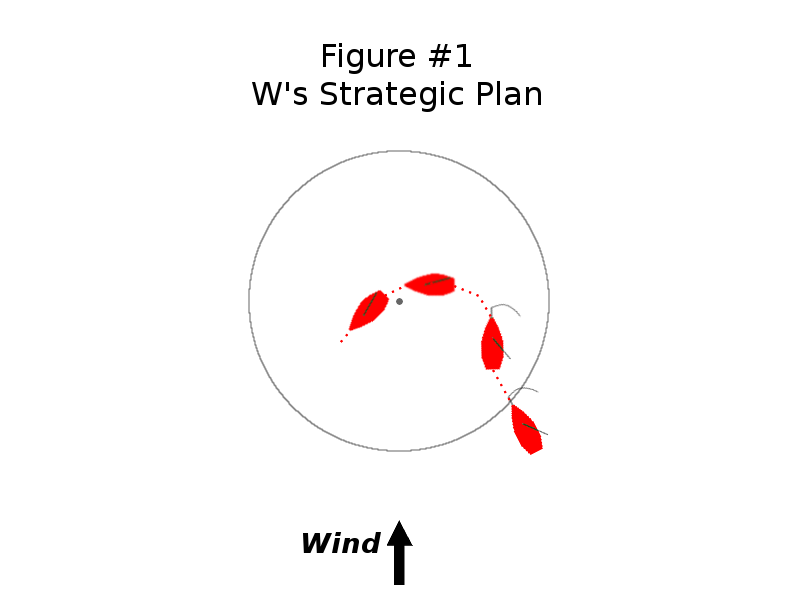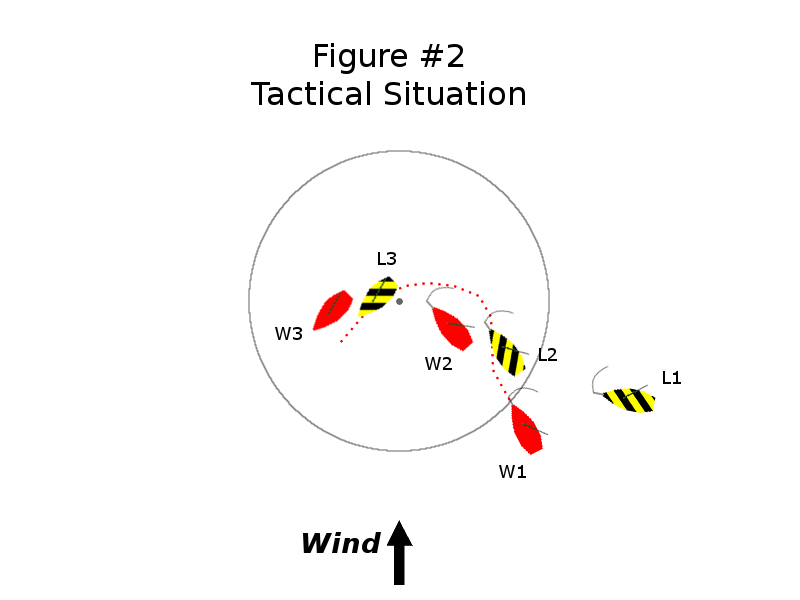
|
This is the LWSA pre-2017 ARCHIVE site. For 2017 and later see the current LWSA site.
Sailing in the Zone, Part One
At the Leeward Mark on the Same Tack and Overlapped
by Edward Baker
Introduction
Sailing in the zone at the leeward mark can be action packed. The fleet which had been dispersed over the entire race course all converge at one point, the mark. Meanwhile the crew is having to wrestle down the gennaker and set the boat up for beating to windward. The helmsman has to maneuver the boat around the mark, avoid other boats and supervise the dousing of the gennaker. It is a "no brainer" for the sailing gurus to suggest that a crew decide on a strategy for rounding the leeward mark early in the downwind leg and to review the tactical situation prior to entering the zone. In the following situation W has decided on a strategy for rounding the leeward mark and boldly sails into the zone...
Situation
W is approaching the leeward mark on a port tack and is about to enter the zone. W's strategy is to conduct a "tactical rounding" also commonly referred to as "wide and tight". W also plans to fall off to dead down wind to facilitate dousing the gennaker. Figure one shows the path W plans steer to effect this strategy.
A properly executed tactical rounding will minimize the loss of boat speed caused by excessive rudder angle and will start W's upwind leg from a point closest to the windward mark. A third advantage is that W can protect it's windward quarter by not allowing a competitor to sail the gap between W and the mark. W's plan to commence the maneuver by falling off to a point dead down wind is also a common practice to facilitate the dousing of the gennaker.


Strategic plans such as W's are based on the assumption that a boat is sailing the course free and clear of all other boats. The actual tactical picture as W approaches this particular leeward mark has W as the windward boat in a two boat, same tack, overlap with L as depicted in figure two. W clearly has entered the zone ahead of L and plans to claim the mark-room it is entitled to over L. As W falls off (turning to the right, away from the mark ) to douse it's gennaker and to commence its tactical rounding maneuver it hails to L for mark-room. L replies with a hail to "stay up" and forces W to alter course to the left and to sail directly to the mark. W hails "protest", displays a red flag and abandons it's plans for a tactical rounding. W's course alteration to port breaks the overlap with L. W approaches the mark at a tighter angle than originally planned passing the mark close aboard to port as it starts it swing to come up close hauled. Instead of entering the rounding wide and exiting tight W now enters tight and exits wide. Meanwhile L takes advantage of W's wide departure from the mark and shoots the gap between W and the mark.
Discussion
 Let's start by looking at
the basic right-of-way situation between L and W. In Figure #3 the leeward
mark
and it's surrounding
zone
have been removed, allowing us to
look at L and W as if they were sailing in open water free of
marks
and
obstructions.
Both L and W are on a port tack and if we draw a line abeam
from the aftermost point of W towards L we also see that an
overlap
exist. L is to
leeward
of W. Given this information we can now determine that
rule 11 - On the Same Tack, Overlapped
is the basic right-of-way rule to apply and therefore W has to
keep clear
of L.
Let's start by looking at
the basic right-of-way situation between L and W. In Figure #3 the leeward
mark
and it's surrounding
zone
have been removed, allowing us to
look at L and W as if they were sailing in open water free of
marks
and
obstructions.
Both L and W are on a port tack and if we draw a line abeam
from the aftermost point of W towards L we also see that an
overlap
exist. L is to
leeward
of W. Given this information we can now determine that
rule 11 - On the Same Tack, Overlapped
is the basic right-of-way rule to apply and therefore W has to
keep clear
of L.
Now that we know the basic right-of-way situation we need to see if there are any restrictions placed on L, the boat with right-of-way. So let's go back to the original situation as shown with W1 and L1 in Figure #2 with W having just entered the zone. Please note that a boat enters the zone when it's hull crosses the three boat-length circle and not it's bowsprit (or other appendage). W's entrance into the zone does indeed place some restrictions on L as detailed in rule 18.2(b) - Giving Mark-Room . L, as the outside boat, must give mark-room to W, the inside boat. L must give W room to steer for the mark but no more. When W arrives at the mark L must allow W to steer a proper course around the mark. Finally, when W has finished rounding and left the mark astern rule 18 will no longer apply.
Is W's protest valid? The definition of mark-room entitles W to room to sail to the mark, that is to say a direct course to the mark. W's course for a tactical rounding falls outside of this definition since it is not a direct course to the mark. At the same time W is overlapped and to windward of L and by rule 11 must stay clear of L. W's attempt to execute a tactical rounding would have violated rule 11; L was correct in holding it's course and forcing W to stay up. In fact L has grounds to protest W (especially if it took evasive action to avoid W). W's portest is invalid.
Mark-room and the zone do not change a boat's obligation to stay clear as per any of the basic right-of-way rules detailed in Part 2, Section A of the rules.
Mark-room does place a limitation on right-of-way boats while in the zone. A right-of-way boat must allow a boat entitled to mark-room to sail directly to the mark in a seamanlike manner and once at the mark, to sail a proper course around the mark.
Mark-room does not entitle a boat to steer a proper course if that course is not a direct course to the mark. Once at the mark a boat with mark-room may steer a proper course around the mark.
Rules
The following rules are from the The Racing Rules of Sailing for 2009-2012 and have been cited in this article:
- 11 On the Same Tack, Overlapped
- When boats ae on the same tack and overlapped, a windward boat shall keep clear of a leeward boat.
- 18.2 Giving Mark-Room
- (b) If boats are overlapped when the first of them reaches the zone, the outside boat at that moment shall thereafter give the inside boat mark-room...
Definitions
The following definitions are from the The Racing Rules of Sailing for 2009-2012 and when used as defined they are shown in italic type.
- Keep Clear
- One boat keeps clear of another if the other can sail it's course with no need to take avoiding action and when the boats are overlapped on the same tack, if the leeward boat can change course in both directions without immediately making contact with the windward boat.
- Leeward and Windward
- A boat's leeward side is the side that is or, when it is head to wind, was away from the wind. However, when sailing by the lee or directly downwind, it's leeward side is the side on which it's mainsail lies. The other side is it's windward side. When two boats are on the same tack overlap, the one on the leeward side of the other is the leeward boat. The other is the windward boat.
- Mark
- An object the sailing instructions require a boat to leave on a specified side...
- Mark-Room
- Room for a boat to sail to the mark and then room to sail a proper course while at the mark...
- Obstruction
- An object that a boat could not pass without changing course substantially, if it were sailing directly towards it and one of it's hull lengths from it. An object that can be safely passed on only one side and an area so designated by the sailing instructions are also obstructions. However, a boat racing is not an obstruction to other boats unless they are required to keep clear of it, give it room or mark-room or, if rule 22 applies, avoid it. A vessel under way, including a boat racing, is never a continuing obstruction.
- Proper Course
- A course a boat would sail to finish as soon as possible in the absence of the other boats referred to in the rule using the term...
- Room
- The space a boat needs in the existing conditions while manoeuvring promptly in a seamanlike way.
- Tack, Starboard or Port
- A boat is on the tack, starboard or port, corresponding to it's windward side.
- Zone
- The area around a mark within a distance of three hull lengths of the boat nearer to it. A boat is in the zone when any part of it's hull is in the zone.
© 2009 Edward Baker

